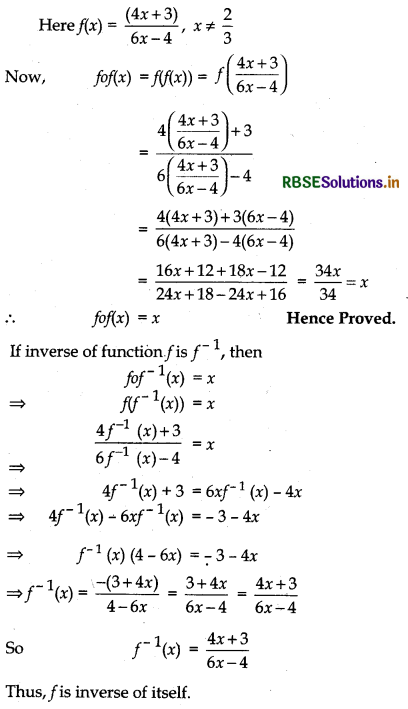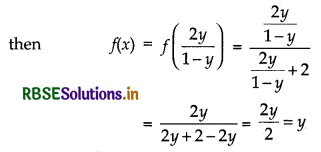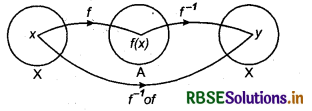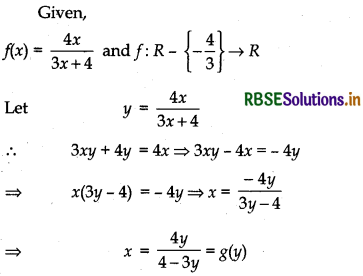RBSE Solutions for Class 12 Maths Chapter 1 Relations and Functions Ex 1.3
Rajasthan Board RBSE Solutions for Class 12 Maths Chapter 1 Relations and Functions Ex 1.3 Textbook Exercise Questions and Answers.
Rajasthan Board RBSE Solutions for Class 12 Maths in Hindi Medium & English Medium are part of RBSE Solutions for Class 12. Students can also read RBSE Class 12 Maths Important Questions for exam preparation. Students can also go through RBSE Class 12 Maths Notes to understand and remember the concepts easily.
RBSE Class 12 Maths Solutions Chapter 1 Relations and Functions Ex 1.3
Question 1.
Let f: {1, 3, 4} {1, 2, 5} and g : {1, 2, 5} → {1, 3} be given by f = {(1, 2), (3, 5), (4, 1)} and g = {(1, 3), (2, 3), (5, 1)}. Write down gof.
Answer:
According to question.
f = {(1, 2), (3, 5), (4, 1)}
and g = {1, 3), (2, 3), (5, 1)}
then f(1) = 2, f(3) = 5, f(4) = 1
and g(1) = 3, g(2) = 3, g(5) = 1
Now, (gof)(1) = g(f(1)) = g(2) = 3
(gof) (3) = g(f(3)) = g(5) = 1
(gof)(4) = g(f(4)) = g(1) = 3
Thus, gof = {(1, 3), (3, 1), (4, 3)}

Question 2.
Let f, g and h be functions from R to R. Show that:
(i) (f + g) oh = foh + goh
(ii) (f . g) oh = (foh).(goh)
Answer:
Given functions are f, g, h, R → R.
(i) ∴ (f + g)oh (x) = (f + g) (h(x))
= f(h(x)) + g(h(x))
= (foh)(x) + (goh)(x)
Thus (f + g)oh = foh + goh
(ii) (f.g)oh(x) = (f.g)(h(x))
= f(h(x)).g(h(x))
= {(foh)(x)}.{goh(x)}
= {(goh) > (goh)} (x)
Thus (f.g)oh = (foh).(goh)
Hence Proved.
Question 3.
Find gof and fog, if
(i) f(x) = |x| and g(x) = |5x - 2|
(ii) f(x) = 8x3 and g(x) = x1/3
Answer:
(i) Given, f(x) = |x| and g(x) = | 5x - 2 |
Then gof(x) = g(f(x)) = g(|x|)
= |5| x |- 2
Now fog(x) = f(g(x)) = f(|5x - 2|)
= | | 5x - 2 | |

(ii) Given, f(x) = 8x3 and g(x) = x1/3
then gof(x) = g(f(x)) = g( 8x3)
= (8x3)1/3
= [(2x)3]1/3
= 2x
Now fog(x) = f(g(x)) = f(x1/3)
= 8(x1/3)3 = 8x
Question 4.
If f(x) = \(\frac{(4 x+3)}{(6 x-4)}\), x ≠ \(\frac{2}{3}\), show that fof(x) = x, for all x ≠ \(\frac{2}{3}\). What is the inverse of f?
Answer:

Note: We can find inverse of /in the following way, also.
Let y = \(\frac{4 x+3}{6 x-4}\)
⇒ 6xy - 4y = 4x + 3
⇒ x(6y - 4) = 4y + 3
⇒ x = \(\frac{4 y+3}{6 y-4}\)
= f(y) (By definition of function)
∴ x = f(y)
⇒ f-1 (x) = y = \(\frac{4 x+3}{6 x-3}\)
∴ f-1 (x) = \(\frac{4 x+3}{6 x-4}\)
Thus, f is inverse of itself.

Question 5.
State with reason whether following functions have inverse
(i) f: {1, 2, 3, 4} → {10} with
f = {(1, 10), (2, 10), (3, 10), (4, 10)}
Answer:
f = {1, 2, 3, 4} → {10}
where f = {(1, 10), (2, 10), (3, 10), (4, 10)}
Inverse, of function f does not exist since it is not one-one onto it is many-one onto.
f(1) = 10, f(2) = 10, f(3) = 10, f(4) = 10
(ii) g: {5, 6, 7, 8} → {1, 2, 3, 4} with
g = {(5, 4), (6, 3), (7, 4), (8, 2)}
Answer:
g = {5, 6, 7, 8} → {1, 2, 3, 4}
where g = {(5, 4), (6, 3), (7,4), (8, 2)}
Here, g(5) = 4, g(6) = 3, g(7) = 4, g(8) = 2
Function is not one-one onto.
It is many one into.
Element 1 of set {1, 2, 3, 4} is not image of any element of set {5, 6, 7, 8}.
Thus, function g is not one-one onto.
Thus, g will not have inverse function.
(iii) h : {2, 3, 4, 5} → {7, 9, 11, 13} with
h = {(2, 7), (3, 9), (4, 11), (5, 13)}
Answer:
h = {2,3, 4, 5} → {7, 9,11,13}
where h = {(2, 7), (3, 9), (4, 11), (5, 13)}
Here, h(2) = 7, h(3) = 9, h(4) = 11, h(5) = 13
Thus, each element of set {2, 3, 4, 5} has unique image in set {7, 9, 11, 13} and there is no element in set {7, 9,11,13}
which has no image of element of set {2,3,4,5}.
Thus, function h is one-one onto.
∴ Inverse of function h is
h-1 = {(7, 2), (9, 3), (11, 4), (13, 5)}
where h-1: {7, 9, 11, 13} → {2, 3, 4, 5}

Question 6.
Show that f: [- 1, 1] → R, given by f(x) = \(\frac{x}{(x+2)}\) is one-one. Find the inverse of the function f: [- 1, 1] → Range f.
(Hint: For y ∈ Range f, y = f(x) = \(\frac{x}{(x+2)}\), or some x in [- 1, 1], i.e., x = \(\frac{2 y}{1-y}\))
Answer:
Let x1, x2 ∈ [- 1, 1] then
f(x1) = f(x2) ⇒ \(\frac{x_{1}}{x_{1}+2}\) = \(\frac{x_{2}}{x_{2}+2}\)
⇒ x1(x2 + 2) = x2(x1 + 2)
⇒ x1x2 + 2x1 = x2x1 + 2x2
⇒ 2x1 = 2x2 ⇒ x1 = x2
Thus, function f: [- 1,1] → R is one-one.
Let y ∈ (range f) is any arbitrary element and y = f(x), where x ∈ [- 1, 1],
Then f(x) = y ⇒ \(\frac{x}{x+2}\) = y
⇒ y(x + 2) = x
⇒ yx + 2y = x
⇒ yx - x = - 2y
⇒ x(y - 1) = - 2y
⇒ x = \(\frac{-2 y}{y-1}\) ⇒ = \(\frac{2 y}{1-y}\), y ≠ 1 ...... (i)
Thus, range of f = R - {1}
Again x = \(\frac{2 y}{1-y}\), y ≠ 1

So, f is onto.
Since, f is one-one onto.
f:[- 1, 1] → R - {1}
Thus, f will be invertible.
Then fof-1(x) = f(f-1(x)) = x
⇒ \(\frac{f^{-1}(x)}{f^{-1}(x)+2}\) = x (by definition of f)
⇒ f-1(x) = xf-1 (x) + 2x
⇒ f-1(x) - xf-1(x) = 2x
⇒ (1 - x)f-1(x) = 2x
⇒ f-1(x) = \(\frac{2 x}{1-x}\)
Thus, inverse of f-1: R - {1} → [-1, 1] is
⇒ f-1(x) = \(\frac{2 x}{1-x}\) (∵ x ≠ 1)

Question 7.
Consider f: R → R given by f(x) = 4x + 3. Show that f is invertible. Find the inverse of f.
Answer:
f(x) = 4x + 3 and f: R → R
Let x1, x2 ∈ R (domain), then
f(x1) = f(x2) ⇒ 4x1 + 3 = 4x2 + 3
⇒ 4x1 = 4x2 ⇒ x1 = x2
Thus, f is one-one.
Again, let y ∈ R (co-domain) is an arbitrary element then in set R (domain) x will be such element for which
f(x) = y
Now y = f(x) ⇒ y = 4x + 3
⇒ y - 3 = 4x ⇒ x = 6 R (domain)
⇒ f(x) = f\(\left(\frac{y-3}{4}\right)\) = 4\(\left(\frac{y-3}{4}\right)\) + 3
= y - 3 + 3 = y
f\(\left(\frac{y-3}{4}\right)\) = y ∈ R (co-domain)
∴ Function is onto.
∵ Function is one-one onto;
so, f is invertible.
Now, for inverse f-1 of f
fof-1 (x) = x
⇒ f(f-1(x)) = x
⇒ 4(f-1(x)) + 3 = x
⇒ 4 (f-1(x)) = x - 3
⇒ f-1(x) = \(\frac{x-3}{4}\)
Thus, inverse of f, f-1(x): R → R is such that
f-1(x) = \(\frac{x-3}{4}\)

Question 8.
Consider f: R+ → [4, ∞) given by f(x) = x2 + 4. Show that f is invertible with the inverse f-1 of given by f-1 (y) = \(\sqrt{y-4}\), where R+ is the set of all non-negative real numbers.
Answer:
Let x1, x2 ∈ R, then
f(x1) = f(x2) ⇒ x12 + 4 = x22 + 4
x12 = x22 ⇒ x1 = x2
Thus, f is one-one.
Again, let y ∈ [4, ∞) is an arbitrary element then x ∈ R+ will be such element for which y = f(x)
Now y = f(x)
⇒ y = x2 + 4
⇒ x2 = y - 4
⇒ x = \(\sqrt{y-4}\), y ≥ 4
For each y ≥ 4, \(\sqrt{y-4}\) ∈ R+
Now f(x) = f(\(\sqrt{y-4}\))
= (\(\sqrt{y-4}\))2 + 4
= y - 4 + 4
= y (By definition of f)
∴ f(\(\sqrt{y-4}\)) = y
Thus, f is onto.
Now, f is one-one onto then it will be invertible.
Thus, f is invertible.
Now, for f-1, inverse of f
fof-1(x) = x
⇒ f(f-1(x)) = x
⇒ [f-1(x)]2 + 4 = x (By definition of f)
⇒ (f-1(x))2 = x - 4
⇒ f-1(x) = \(\sqrt{x-4}\)
⇒ f-1(y) = \(\sqrt{y-4}\)
Note: f(\(\sqrt{y-4}\)) = y
∴ f-1 = \(\sqrt{y-4}\)
Which is inverse function of f.

Question 9.
Consider f: R+ → [- 5, ∞) given by f(x) = 9x2 + 6x - 5.
Show that f is invertible with f-1 (y) = \(\left(\frac{\sqrt{(y+6)}-1}{3}\right)\)
Answer:
Let x1, x2 ∈ R+ then
f(x1) = f(x2)
9x12 + 6x1 - 5 = 9x22 + 6x2 - 5
⇒ 9x12 + 6x + 1 - 6 = 9x22 + 6x2 + 1 - 6
⇒ (3x1 + 1)2 - 6 = (3x2 + 1)2 - 6
⇒ 3x1 + 1 = 3x2 + 1 [∵ x1, x2 ∈ R+]
⇒ 3x1 = 3x2
⇒ x1 = x2
Thus, f is one-one.
Again, let y ∈ [- 5, ∞) is any arbitrary element then x e R+ will be such element for which y = f(x), then
y = f(x)
⇒ y = 9x2 + 6x - 5
⇒ y = 9x2 + 6x + 1 - 1 - 5
⇒ y = (3x + 1)2 - 6
⇒ (3x + 1)2 = y + 6

Thus, f is onto.
Since, f is one-one onto so f is invertible.
From (i), f-1(y) = \(\left(\frac{\sqrt{y+6}-1}{3}\right)\)
or
fof-1(x) = x (∵ f-1, inverse of function f)
⇒ f(f-1(x)) = x
⇒ 9(f-1(x))2 + 6f-1(x) - 5 = x
⇒ 9(f-1(x))2 + 6f-1(x) + 1 - 1 - 5 = x
⇒ (3f-1(x) + 1)2 = x + 6
⇒ 3f-1(x) + 1 = \(\sqrt{x+6}\)
⇒ 3f-1(x) = \(\sqrt{x+6}\) - 1
⇒ f-1 (x) = \(\left(\frac{\sqrt{x+6}-1}{3}\right)\)
Thus f-1 (y) = \(\left(\frac{\sqrt{(y+6)}-1}{3}\right)\)
where f-1 (y), is inverse of f(y).
Hence Proved.

Question 10.
Let f: X → Y be an invertible function. Show that/has unique inverse. (Hint: Suppose^ andg2 are two inverses off. Then for all y ∈ Y, fog1(y) = IY(y) = fog2(y). Use one-one ness of f).
Answer:
Given that f: X → Y, is invertible so it will be one- one onto.
Let g1, g2 are two inverse of f.
then fog1(y) = Iy(y) ......... (i)
and fog2(y) = Iy(y) ......... (ii)
From (i) and (ii), we get
fog1(y) = fog2(y)
(Since, Iy(y) will be one not two )
⇒ f(g1(y)) = f(g2(y))
⇒ g1(y) = g2(y)
⇒ g1 = g2 [Since f is one-one]
Thus f(x1) = f(x2)
⇒ x1 = x2
i.e., inverse of f is unique.
Hence Proved.

Question 11.
Consider f: {1, 2, 3} → {a, b, c} given by f(1) = a, f(2) = b and f(3) = c. Find f-1 and show that (f'-1)-1 = f.
Answer:
f: {1, 2, 3} → {a, b, c}, f(1) = a, f(2) = b, f(3) = c.
Writing function f in ordered pair form:
f = {(1, a), (2, b), (3, c)}
Clearly, each element of set {1, 2, 3} has distinct image in set {a, b, c} and there is no element in set {a, b, c) which is not the image of any element of set {1, 2, 3}. Thus, function f is one-one onto. Hence, function f is invertible.
Let inverse of f is f-1.
Then in f = {(1, a), (2, b), (3, c)} by interchanging the elements f-1 will be obtained.
Thus, f-1 = {(a, 1), (b, 2), (c, 3)}
i.e., f-1: {a, b, c} → {1, 2, 3} will be defined as:
f-1(a) = 1, f-1(b) = 2, f-1(c) = 3
Since, function f is one-one onto so its inverse f-1 be one-one onto then inverse of f-1 will be (f-1)-1.
Thus, by interchanging the elements of ordered pair in
f-1 = {(a, 1), (b, 2), (c, 3)} we will get (f-1)-1.
Thus, (f-1)-1 = {(1, a), (2, b), (3, c)} = f (By definition of f)
Here (f -1)-1(1) = a, (f-1)-1 (2) = b and (f-1)-1(3) = c, which is definition of f.
Hence Proved.
Question 12.
Let f: X → Y be an invertible function. Show that the inverse of f-1 is f, i.e., (f-1)-1 = f.
Answer:
It is given that f: X → Y is invertible. We have to prove that inverse of f-1 is f i.e.
(f-1)-1 = f
Here, to show f-1of = IX and fof-1 = Iy will be sufficient for(f-1)-1 = f.
Clearly f: X → Y is one-one onto.
∴ f-1: Y → X is one-one onto.
Let x ∈ X and f(x) = y then f-1(y) = x
∴ (f-1of) = f-1(f(x))
= f-1(y) [∵ f(x) = y]
= x = Ix(x)

where Ix(x) is identity function.
∴ f-1of = Ix
Again, function f is onto, then x ∈ X will be such that f(x) = y, then f-1(y) = x
∴ (fof-1) (y) = f(f-1(y)) = f(x)
= y (∵ f-1(y) = x)
= IY(y)
Thus, f-1of = IX and fof-1 = IY
∴ (f-1)-1 = f
Hence Proved.
IInd Method: Since, we know that inverse of any bijective function is bijective.
∴ f-1: Y → X will also be bijective
Now, f-1 : Y → X is bijective, then (f-1)-1: X → Y will also be bijective
Let x ∈ X is an arbitrary element.
∴ (f-1)-1 (x) = f(x), ∀ x ∈ A
Thus, (f-1)-1 = f
Hence Proved.

Question 13.
If f: R → R be given by f(x) = \(\left(3-x^{3}\right)^{\frac{1}{3}}\) , then fof(x) is:
(A) \(x^{\frac{1}{3}}\)
(B) x3
(C) x
(D) (3 - x3)
Answer:
Given f(x) = (3 - x3)1/3,f: R → R
Now, fof(x) = f(f(x))
= f[(3 - x3)1/3]
= [{3 - {3 - x3)1/3}3]1/3
= [3 - (3 - x3)]1/3
= (3 - 3 + x3)1/3
= (x3)1/3
= x
Thus, option (C) is correct.
Question 14.
Let f: R - \(\left\{-\frac{4}{3}\right\}\) → R be a function defined as f(x) = \(\frac{4 x}{3 x+4}\). The inverse of f is the map g: Range f → R - \(\left\{-\frac{4}{3}\right\}\) given by.
(A) g(y) = \(\frac{3 y}{3-4 y}\)
(B) g(y) = \(\frac{4 y}{1-3 y}\)
(C) g(y) = \(\frac{4 y}{34-4}\)
(D) g(y) = \(\frac{4 y}{3-4 y}\)
Answer:

Thus, option (B) is correct.

- RBSE Class 12 Maths Notes Chapter 13 Probability
- RBSE Class 12 Maths Notes Chapter 12 Linear Programming
- RBSE Class 12 Maths Notes Chapter 11 Three Dimensional Geometry
- RBSE Class 12 Maths Notes Chapter 10 Vector Algebra
- RBSE Class 12 Maths Notes Chapter 9 Differential Equations
- RBSE Class 12 Maths Notes Chapter 8 Application of Integrals
- RBSE Class 12 Maths Notes Chapter 7 Integrals
- RBSE Class 12 Maths Notes Chapter 6 Application of Derivatives
- RBSE Class 12 Maths Notes Chapter 5 Continuity and Differentiability
- RBSE Class 12 Maths Notes Chapter 4 Determinants
- RBSE Class 12 Maths Notes Chapter 3 Matrices